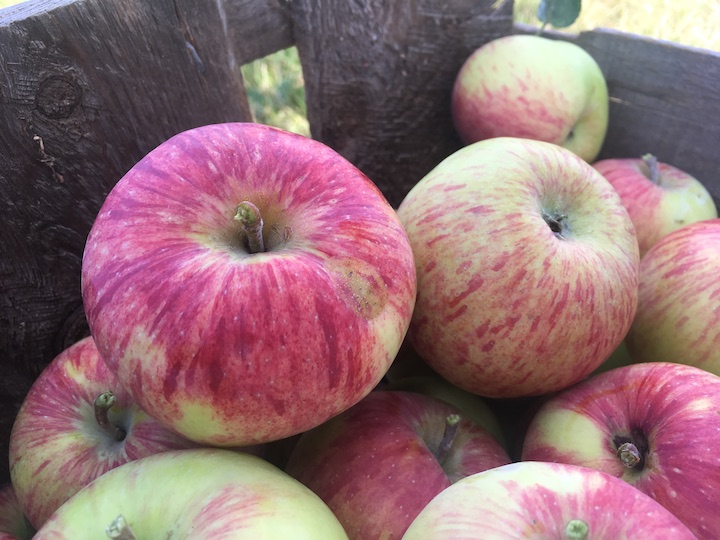By C.J. Walke, MOFGA’s Orchard Program Manager
For decades, fruit enthusiasts, explorers and experts have worked tirelessly to determine the identity of varieties found in abandoned orchards and on random roadside trees, and even the relatively younger tree that lost its nursery tag along the way. A lot of this detective work revolves around the enthusiast’s experience with fruit identification, as well as a great depth of knowledge about the history of apple cultivation and the apple industry in the region where the cultivar in question still stands. Various resources exist to aid in the identification (agricultural reports, historic documents, print books filled with colored plates of varieties, etc.), but oftentimes when it comes right down to it, the determination is based on the confidence of the identifier and even a bit of “gut feeling” about the variety in hand.
Since 2019, staff and volunteers at the Maine Heritage Orchard (MHO) have been collaborating with tree fruit geneticists at Washington State University’s Department of Horticulture on the genetic fingerprinting of apple varieties in the orchards on the MOFGA grounds and around Maine. WSU’s research lab consists of a team of researchers, led by Cameron Peace, Ph.D., with decades of experience studying genetic profiles of apple and cherry trees from around the world. They have collected genetic data from thousands of apple and sweet cherry cultivars that have been grown across the United States and use this dataset to compare and identify collected samples they receive at the lab in Pullman, Washington.

To submit our apple tissue samples from MHO, we collect leaves from the varieties in question during the growing season. We typically collect the youngest leaves near the tip of a healthy, actively growing shoot of the tree. These leaves tend to be very light green in color, still a bit curled up, not completely unfurled, and a little fuzzy or hairy in texture. We pinch off three to six of these young leaves from a single tree and put them into a sample tube we’ve received from the WSU lab. When we are sampling multiple trees, we are careful about cross-contamination of the samples, since our hands may contain DNA from the previous sample.
The tube, a 15 milliliter Falcon conical tube, contains silica beads that dry out the leaves and stabilize the sample, which can remain at room temperature indefinitely but needs to be kept out of direct sunlight. The tube also contains a few blue indicator beads that will turn pink if there is too much moisture in the tube or on the leaves, which indicates that the sample may be too degraded to test, so another sample must be collected. And of course, all samples are properly labeled according to the tree they represent and well tracked via spreadsheets to keep our MHO variety data accurate, though an occasional mistake does occur.
Some of our recent findings have confirmed our suspicions and some have pointed out some inaccuracies about apple trees we have here on the MOFGA grounds. What we thought was Brigg’s Auburn, a variety originally from Androscoggin County, is actually Northwestern Greening. Our Nutting Bumpus, an Aroostook County variety, is actually Duchess of Oldenburg, an old variety of Russian origin. And our Marlboro from Hancock County turned out to be King of Tompkins County. We think we have now found the true Marlboro, but the others remain elusive.
Part of the challenge is interpreting historical data and anecdotal evidence tied to the story of a particular variety. Over generations, names can get mixed up and stories can fluctuate, especially when the origins are centuries old and initially shared by word of mouth until details are eventually written. But even then, interpretations and viewpoints are subject to human error.
Until recently, DNA profiling or fingerprinting of these apple and cherry varieties has been the work of a handful of partners, but now WSU has opened up the opportunity to the general public through their project called MyFruitTree (myfruittree.org). Through this project, fruit explorers, farmers, backyard orchardists and others can submit samples for testing to help identify unknown varieties or lost identities. Samples are confirmed via a match in the existing dataset but could also detect uniqueness of a seedling apple that is not in the current dataset.
Interested fruit enthusiasts can visit the MyFruitTree contact page (myfruittree.org/contact) to submit their tree information and start the process. MyFruitTree asks for some details about the tree or trees you are looking to identify, such as the potential cultivar, age, unique characteristics, etc., and there’s even an option to upload photos of the trees. There is a fee for the analysis ($50 for matching to known varieties), and it will most likely take a few months for the results because tests are run in batches of nearly 400, but the results are worth the wait.
This article was originally published in the fall 2023 issue of The Maine Organic Farmer & Gardener.

